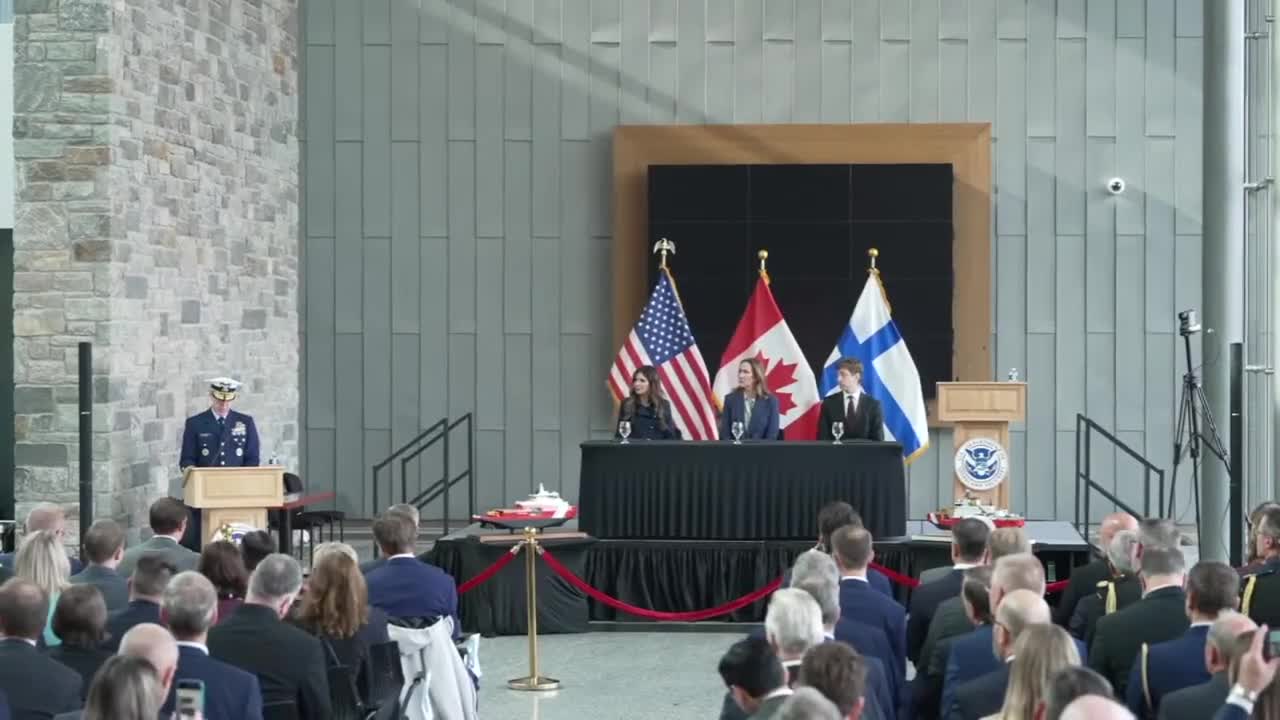U.S., Canada and Finland sign ICEPACT statement to speed joint icebreaker design, build and workforce plan
November 19, 2025 | Department of Homeland Security

This article was created by AI summarizing key points discussed. AI makes mistakes, so for full details and context, please refer to the video of the full meeting. Please report any errors so we can fix them. Report an error »

Leaders from the United States, Canada and Finland signed a joint statement of intent at the Douglas A. Monroe Coast Guard Headquarters to advance trilateral cooperation on Arctic icebreaker design, shipbuilding and workforce development.
Admiral Kevin Lundy, acting commandant of the U.S. Coast Guard, opened the principals meeting and framed it as a commitment to "advancing Arctic security, industrial cooperation, and workforce development." Secretary of Homeland Security Kristi Noem said the effort is intended to "secure our supply chains" and rebuild U.S. shipyards so the nations can deliver the icebreakers they need.
“No nation will cede the high ground in the Arctic on our watch,” Noem said, arguing that icebreakers are essential to maintain presence and sovereignty. She announced the release of the ICEPACT U.S. National Defense Workforce and Development Plan, which she described as a framework for expanding U.S. shipbuilding capacity and creating long-term jobs tied to Arctic vessel construction.
Ambassador Kirsten Hillman of Canada highlighted Ottawa’s planned investments in Arctic infrastructure and defense, telling the meeting Canada is investing "over $30,000,000,000 in our defense security over the next 5 years" and will leverage commercial and naval shipbuilding expertise to support joint construction. Hillman said the United States has selected a multipurpose design developed by Canadian and Finnish partners and that Canadian yards will contribute to building several vessels.
Finland’s Minister of Economic Affairs, Sakari Puisto, described Finland’s century of icebreaking experience and technical contributions — from propulsion systems to hull materials — as the basis for the partnership’s industrial work and research-and-development cooperation.
Officials said some initial vessels are under construction with foreign yards while U.S. shipyards scale up to take on later work. The delegates signed a joint statement of intent under ICEPACT to strengthen industrial capacity, information sharing, and workforce development, and then took questions from the press.
The signatories and their teams framed the agreement as a policy and industrial roadmap rather than a binding procurement contract; the joint statement formalizes shared goals to coordinate design, construction and workforce training across the three countries.
Admiral Kevin Lundy, acting commandant of the U.S. Coast Guard, opened the principals meeting and framed it as a commitment to "advancing Arctic security, industrial cooperation, and workforce development." Secretary of Homeland Security Kristi Noem said the effort is intended to "secure our supply chains" and rebuild U.S. shipyards so the nations can deliver the icebreakers they need.
“No nation will cede the high ground in the Arctic on our watch,” Noem said, arguing that icebreakers are essential to maintain presence and sovereignty. She announced the release of the ICEPACT U.S. National Defense Workforce and Development Plan, which she described as a framework for expanding U.S. shipbuilding capacity and creating long-term jobs tied to Arctic vessel construction.
Ambassador Kirsten Hillman of Canada highlighted Ottawa’s planned investments in Arctic infrastructure and defense, telling the meeting Canada is investing "over $30,000,000,000 in our defense security over the next 5 years" and will leverage commercial and naval shipbuilding expertise to support joint construction. Hillman said the United States has selected a multipurpose design developed by Canadian and Finnish partners and that Canadian yards will contribute to building several vessels.
Finland’s Minister of Economic Affairs, Sakari Puisto, described Finland’s century of icebreaking experience and technical contributions — from propulsion systems to hull materials — as the basis for the partnership’s industrial work and research-and-development cooperation.
Officials said some initial vessels are under construction with foreign yards while U.S. shipyards scale up to take on later work. The delegates signed a joint statement of intent under ICEPACT to strengthen industrial capacity, information sharing, and workforce development, and then took questions from the press.
The signatories and their teams framed the agreement as a policy and industrial roadmap rather than a binding procurement contract; the joint statement formalizes shared goals to coordinate design, construction and workforce training across the three countries.
View full meeting
This article is based on a recent meeting—watch the full video and explore the complete transcript for deeper insights into the discussion.
View full meeting